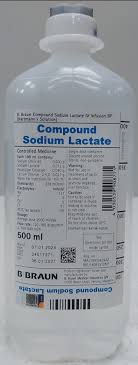|
Getting your Trinity Audio player ready... |
Hartmann’s: What is Hartmann’s Solution?
Hartmann’s solution, also known as compound sodium lactate or Ringer’s lactate solution, is an intravenous fluid commonly used to help restore blood volume in patients experiencing circulatory problems, such as shock. It can also be used to administer sodium and water when oral intake is not possible.
Primarily, the solution aims to replace lost fluids, often during fluid resuscitation, particularly in cases of significant blood loss, trauma, burns, or after surgery. It can also serve for maintenance fluid therapy in other scenarios.
Hartmann’s solution is often chosen over normal saline because it contains both fluids and electrolytes, offering a more balanced composition. Additionally, it tends to have fewer side effects and can be safely administered to both adults and children.
Origins of Hartmann’s Solution
Hartmann’s solution was first developed in the late 19th century by British physician Sidney Ringer, who was investigating the ions needed to maintain the function of a frog heart outside the body. In the 1940s, American pediatrician Alexis Hartmann modified the original formula by adding lactate, which helps treat metabolic acidosis. Lactate is converted into bicarbonate by the liver, thereby aiding in the correction of acidosis. This modification is why the solution is sometimes called Ringer’s lactate or simply Hartmann’s solution.
Composition of Hartmann’s Solution
Hartmann’s solution contains several key components that make it effective in treating fluid and electrolyte imbalances:
- Sodium ions (131 mmol/L) – Sodium plays a critical role in maintaining fluid balance, osmotic pressure, and acid-base equilibrium. The sodium content helps replace lost fluids and supports the circulatory volume.
- Chloride ions (111 mmol/L) – Chloride is an essential electrolyte that works in concert with sodium to maintain the body’s fluid balance. It also plays a role in regulating blood pressure and ensuring proper cellular function.
- Calcium ions (2 mmol/L) – Calcium is crucial for muscle function, nerve transmission, and blood clotting. It helps maintain the integrity of cell membranes and supports enzymatic activities.
- Potassium ions (5 mmol/L) – Potassium is vital for maintaining normal cell function, particularly nerve transmission and muscle contraction. Potassium levels must be carefully monitored to prevent conditions such as hyperkalemia.
- Lactate (29 mmol/L) – As discussed, lactate is included to address metabolic acidosis. It is converted by the liver into bicarbonate, which helps buffer excess hydrogen ions and correct the pH of the blood.
The solution is designed to be isotonic, meaning that it has the same osmolarity as blood (273 mOsm/L), making it ideal for intravenous administration as it doesn’t cause fluid shifts between the intracellular and extracellular compartments.
Lactate is specifically added to help manage metabolic acidosis, though this requires normal liver function for proper lactate conversion to bicarbonate.
The sodium content in Hartmann’s solution makes it effective for replenishing both sodium and water in cases of fluid depletion. The solution has a similar tonicity to blood, with an osmolarity of 273 mOsm/L.
Clinical Uses of Hartmann’s Solution
Hartmann’s solution is commonly used in various medical situations. Its ability to restore circulatory volume and correct electrolyte imbalances makes it particularly valuable in emergency and surgical settings. Here are some specific scenarios where Hartmann’s solution is frequently utilized:
- Shock and Trauma: In cases of severe blood loss or shock, Hartmann’s solution is used for fluid resuscitation to maintain blood pressure and improve circulation. It helps to replace both water and electrolytes that are lost due to trauma, hemorrhage, or dehydration.
- Burns: Severe burns lead to significant fluid and electrolyte losses. Hartmann’s solution helps restore these losses and prevent complications such as hypovolemic shock.
- Surgery: During surgical procedures, especially those that involve large blood losses or extensive tissue damage, Hartmann’s solution is used to maintain fluid balance and prevent hypovolemia.
- Metabolic Acidosis: The lactate component of Hartmann’s solution plays a role in correcting metabolic acidosis by converting to bicarbonate in the liver.
- Electrolyte Imbalances: In patients with conditions like hyperkalemia or hyponatremia, Hartmann’s solution provides a balanced mixture of electrolytes, helping to correct these imbalances.
Adverse Effects and Warnings
While Hartmann’s solution is generally well-tolerated, there are some risks and potential side effects:
- Fluid Overload: Administering too much Hartmann’s solution can strain the heart, leading to a reduction in cardiac output or even severe heart failure. This occurs when the solution increases left ventricular filling beyond the heart’s ability to contract, as described by the Starling curve.
- Swelling: Swelling may occur, especially if sodium is administered too rapidly and the body is slow to eliminate it.
- Hyperkalemia: While the potassium content is relatively low, there is still a risk of hyperkalemia, particularly in patients with kidney dysfunction.
- Renal and Hepatic Concerns: In patients with impaired kidney function, the volume of Hartmann’s solution should be carefully managed to avoid fluid overload. Additionally, patients with severe liver disease may not metabolize lactate effectively, making the solution unsuitable for them.
- Heart Failure: In patients with heart failure, the volume of Hartmann’s solution should be reduced to avoid worsening heart muscle contractility.
Hartmann’s solution is less likely to cause hyperchloremic acidosis than sodium chloride due to its lower chloride ion content, making it a preferred option in many cases.
Overall, while Hartmann’s solution is a vital tool in treating fluid imbalances and circulatory issues, its use requires careful monitoring, especially in patients with kidney, heart, or liver conditions. Despite these considerations, it remains a relatively safe option with minimal risk of clinically significant drug interactions.

